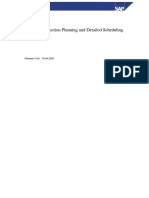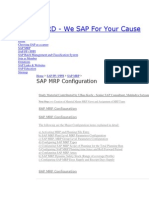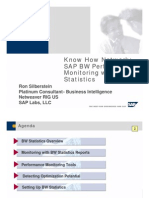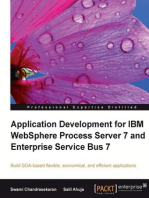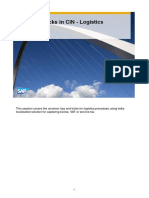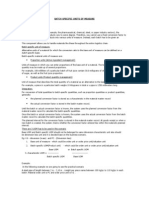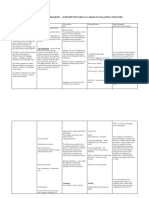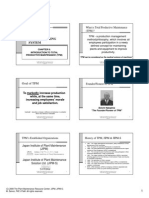0 ratings0% found this document useful (0 votes)
41 viewsRouting PRT - Present1
Routing PRT - Present1
Uploaded by
Amit AggarwalThis document provides an overview of routing components and functions in SAP. It describes that routings contain steps, work centers, resources, material allocation and standard times. It also explains how to create alternative and parallel sequences in routings, use production resources/tools, reference operation sets, and sub-operations. The objectives are to be able to maintain a routing with operations, configure routing administration settings, and create and use various routing components.
Copyright:
© All Rights Reserved
Available Formats
Download as PPT, PDF, TXT or read online from Scribd
Routing PRT - Present1
Routing PRT - Present1
Uploaded by
Amit Aggarwal0 ratings0% found this document useful (0 votes)
41 views20 pagesThis document provides an overview of routing components and functions in SAP. It describes that routings contain steps, work centers, resources, material allocation and standard times. It also explains how to create alternative and parallel sequences in routings, use production resources/tools, reference operation sets, and sub-operations. The objectives are to be able to maintain a routing with operations, configure routing administration settings, and create and use various routing components.
Original Description:
ROUTING
Original Title
Routing PRT_Present1
Copyright
© © All Rights Reserved
Available Formats
PPT, PDF, TXT or read online from Scribd
Share this document
Did you find this document useful?
Is this content inappropriate?
This document provides an overview of routing components and functions in SAP. It describes that routings contain steps, work centers, resources, material allocation and standard times. It also explains how to create alternative and parallel sequences in routings, use production resources/tools, reference operation sets, and sub-operations. The objectives are to be able to maintain a routing with operations, configure routing administration settings, and create and use various routing components.
Copyright:
© All Rights Reserved
Available Formats
Download as PPT, PDF, TXT or read online from Scribd
Download as ppt, pdf, or txt
0 ratings0% found this document useful (0 votes)
41 views20 pagesRouting PRT - Present1
Routing PRT - Present1
Uploaded by
Amit AggarwalThis document provides an overview of routing components and functions in SAP. It describes that routings contain steps, work centers, resources, material allocation and standard times. It also explains how to create alternative and parallel sequences in routings, use production resources/tools, reference operation sets, and sub-operations. The objectives are to be able to maintain a routing with operations, configure routing administration settings, and create and use various routing components.
Copyright:
© All Rights Reserved
Available Formats
Download as PPT, PDF, TXT or read online from Scribd
Download as ppt, pdf, or txt
You are on page 1of 20
Course Objectives
At the conclusion of this unit, you will be able to:
l Maintain a routing with operations.
l Carry out the system settings for routing
administration
l Create and use a production resources/tools
(PRT) in a routing
l Create alternative and parallel sequences
l Create and use a reference operation set in a
routing
Routings
Routings - Components
Routing - Components
SAP AG 06/23/97
R
Routings
Routings contain:
The steps required to produce or make an assembly
The work centers where the steps are to be performed
The resources and tools necessary to complete a step at a work
center
Material allocation
The material being manufactured is allocated to the group
counter (header)
Component materials are allocated to operations
Standard values for setup, processing, and tear-down time
Instructions of what to do at each work step
Skills required to do each step in the assembly process
Routings
SAP AG 06/23/97
R
Routings
l A material can be manufactured in different
ways.
l For each material, you can create several
routings for different
Lot size ranges
Work centers
Usages, including
Production
Rework
Prototype
Routing - Group
SAP AG 06/23/97
R
Routings
l Routings are stored in groups of similar or related routings.
l Each individual routing is referred to as a group counter
within the group
Routing Group
Group Group
Counter 01 Counter 01
Group Group
Counter 02 Counter 02
Group Group
Counter 03 Counter 03
Group Group
Counter 04 Counter 04
Routing - Group
Tasklist Types
SAP AG
Operation 10
20
30
.
.
.
Routing Reference operation set Routing
S1
Operation 10
20
30
.
.
.
Material
Task List Types
Rate routing
Reference rate routing
Routing- Sequence Types
SAP AG
Routing
Material
Group
Sequence types
Material
A
task list
99
02
task list
Task l ist
01
Alternative sequence
0001
Oper.10
Oper.15
Oper.20
Parallel sequence
0002
Oper. 70
Oper. 80
Standard seq.
0000
Oper. 10
Oper. 20
Oper. 30
Oper. 40
Oper. 50
Oper. 60
Oper. 70
Oper. 80
Oper. 90
Oper.100
Tasklist - Default Values
SAP AG
Origin of Default Values in Task Lists
Profile
Work center PRT
Material master
Reference
Control key x
Standard text key x
Unit of measure x
Formulas x
Scheduling data x
Reference
Control key x
Standard text key x
Standard value check
Unit of measure for
standard values
Activity types x
Wage type x
Wage group x
No. of time tickets x
Suitability x
Setup type key x
Description
Base unit of measure
Planner group
Plant
Unit of measure
Usage
Status
Operation increment
Material Allocation
SAP AG
Material Allocation
A
Material
B
Material
Routing
BOM
Op. 10
Op. 20
Op. 30
Item 20
Item 10
Item 30
BOM
Item 20
Item 10
PRT Assignments
SAP AG
Production Resource/Tool Assignments
Routing
Operation 10
Operation 20
Operation 30
PRT 1
PRT 2
Sequences in Routing
SAP AG
Sequences in Routing
Operation 10
Operation 20
Operation 30
Operation 40
Operation 50
Main sequence
0000
Main sequence
0000
Main sequence
0000
Alternative seq.
0002
20
25
30
Alternative seq.
0002
20
25
30
Alternative seq.
0002
20
25
30
Alternative seq.
0001
10
15
20
25
30
Alternative seq.
0001
10
15
20
25
30
Alternative seq.
0001
10
15
20
25
30
Parallel Sequences
SAP AG
Parallel Sequences
20 25 30
Operation
10 20 30 40
20 30
Scheduling in PP
SAP AG
Scheduling in Production Planning
Separate scheduling of planned orders
Exact to the day
Basic dates calculated Planned start date
Planned delivery date
Creation date
Uses lot-dependent/lot-independent in-house production
or replenishment lead time
Optionally use basic planning days from the material
master to improve performance
Optional calculation of capacity requirements
Production order management
Order header Order header
oper at ions
ma te ria l c om pone nts
P RTs
c ost s pla nned
t arge t
a ct ual
20
50
100
Material Requirements Planning
t
Periods
Lead time scheduling
Exact to the second
Based on basic date MRP
Manual
Target dates calculated (scheduled dates)
Target start date
Target finish date
Operation specific data used to calculate order dates
Capacity requirements calculated
Scheduling
SAP AG
Scheduling: Time Elements in an Order
Order dates Operation dates Time terms
BS Basic start date
SS Scheduled start date (production start date)
SF Scheduled finish date
BF Basic finish date
AD Availability date (expected)
LT Loading time
GI Goods issue
DDD Desired delivery date
ES Earliest start date
LS Latest start date
EF Earliest start date
LF Latest finish date
Lead time order or
operation
Lead time order or
operation
Lead time order or
operation
Float times order Float times order Float times order
Execution time operation Execution time operation Execution time operation
Interoperation times Interoperation times Interoperation times
Processing times in
Sales and Distribution
Processing times in
Sales and Distribution
Processing times in
Sales and Distribution
Float bef.
production
Oper.
0010
Oper.
0020
Oper.
0030
Oper.
0040
........ Oper.
0099
Float after
production
GR
processing
Pick/pack Loading Transit
BS SS
Queue Setup Processing Teardown Wait Move
SF BF DDD GI LT AD
ES LS EF LF
Reference Operation Set
SAP AG
Reference Operation Set
Reference operation set
Check
10 10 10
Routing
Operation created manually
Operations with reference
to assembly in
reference operation set
Check reference
60 60 60
Operation created manually
Check reference 70 70 70
10 10 10
20 20 20
30 30 30
40 40 40
50 50 50
Assembly
10 10 10
20 20 20
30 30 30
Sub Operations in Routing
SAP AG
Sub-operation
Operation 10
Operation 20
Sub-op 10/20 Processing 1
Sub-op 10/10
Setup
Sub-op 10/30 Processing 2
Scheduling
SAP AG
Scheduling Sub-operations
Queue Queue Wait Wait
Finish reference
to offset
Execution Execution
10 30 20
T
S
20/10 20/10
20/20
Start reference
to offset
Start reference
to offset
20/30
BS BF
SS SF
Finish reference
Move Move
Summary
You are now able to:
l Create a routing with a simple sequence of
operations
l Carry out the system settings for routing
administration
l Maintain a routing with PRTs as well as alternative
and parallel sequences
l Create and use reference operation sets in
routings
You might also like
- Routings & PRTDocument18 pagesRoutings & PRTShaffiullahNo ratings yet
- Study Routing Material Contributed by Ulhas KavleDocument23 pagesStudy Routing Material Contributed by Ulhas Kavlesaisuni.mNo ratings yet
- SAP Overview: Sap PP (Production Planning) Course ContentsDocument4 pagesSAP Overview: Sap PP (Production Planning) Course ContentsShahilSinghNo ratings yet
- Routing SDocument24 pagesRouting SanjitachinkiNo ratings yet
- SAP - PP - Configurations XDocument5 pagesSAP - PP - Configurations XCamran KhanNo ratings yet
- SAP PP ConfigurationsDocument7 pagesSAP PP ConfigurationsArvind Sharma100% (1)
- Technical Information On How The Planning Run Works: ContentsDocument50 pagesTechnical Information On How The Planning Run Works: ContentsMárcio NascimentoNo ratings yet
- PP Config TCode ListDocument9 pagesPP Config TCode Listshiv_patel14No ratings yet
- Organization and Plant Maintenance Structure (Sap) Integration ChartDocument9 pagesOrganization and Plant Maintenance Structure (Sap) Integration ChartSaif Ali Momin100% (1)
- Material Requirements Planning & ERP PPT at BEC DOMSDocument44 pagesMaterial Requirements Planning & ERP PPT at BEC DOMSBabasab Patil (Karrisatte)No ratings yet
- My Preparation TopicsDocument10 pagesMy Preparation TopicsGokulNo ratings yet
- Transacciones SAPDocument8 pagesTransacciones SAPsebastianmoniciNo ratings yet
- SAP Principal TablesDocument17 pagesSAP Principal TablesTapas DuttaNo ratings yet
- TCODESDocument47 pagesTCODESgangusandeepkumarNo ratings yet
- Sap Production Planning (Old)Document100 pagesSap Production Planning (Old)Nina PagkatipunanNo ratings yet
- SAP T-CodesDocument6 pagesSAP T-CodesSudipto MitraNo ratings yet
- SAP PP OverviewDocument83 pagesSAP PP OverviewFrank FengNo ratings yet
- Computer Aided Test Tool (CATT) : VSDK 3.0Document41 pagesComputer Aided Test Tool (CATT) : VSDK 3.0krizvlNo ratings yet
- PPDS CourseDocument397 pagesPPDS CourseElan75% (4)
- CA 01 Create RoutingDocument23 pagesCA 01 Create RoutingEric GambonNo ratings yet
- Technical Aspects in LIS With Special Focus On ProductionDocument108 pagesTechnical Aspects in LIS With Special Focus On Productiondinhlap237No ratings yet
- MRPDocument27 pagesMRPRAMAKRISHNA.GNo ratings yet
- Factory CalendarDocument4 pagesFactory Calendarsandeep prajapatiNo ratings yet
- Basis Ecc6 TcodesDocument10 pagesBasis Ecc6 TcodesRajesh BabuNo ratings yet
- Inv Accountignwith MLDocument14 pagesInv Accountignwith MLSamik BiswasNo ratings yet
- TcodesDocument9 pagesTcodesDiego Gaspar VenturaNo ratings yet
- AC040 Cost Management and Controlling Part IDocument56 pagesAC040 Cost Management and Controlling Part IOuddie Terdwongwarakul100% (2)
- SAP PP ConfigurationDocument15 pagesSAP PP ConfigurationMohammed R Siddiqui100% (1)
- Chemical Industry TemplateDocument25 pagesChemical Industry Templatedoriangray661No ratings yet
- Manufacturing and Production Planning Table of ContentsDocument4 pagesManufacturing and Production Planning Table of ContentsramvepuriNo ratings yet
- SAP HR Tcodes and All Basis Useful Transaction Codes.Document47 pagesSAP HR Tcodes and All Basis Useful Transaction Codes.Manoj Kumar GangineniNo ratings yet
- SAP Routing & RecipesDocument28 pagesSAP Routing & RecipesmohamedNo ratings yet
- Top 26 SAP PP Interview QuestionsDocument6 pagesTop 26 SAP PP Interview QuestionsPawan KumarNo ratings yet
- What Is SAP PM PDFDocument47 pagesWhat Is SAP PM PDFRahul KandorNo ratings yet
- SAP APO PPDS For Automotive PDFDocument92 pagesSAP APO PPDS For Automotive PDFOshun Tang100% (6)
- BPMLDocument19 pagesBPMLKalyan Varma TirumalarajuNo ratings yet
- PP ConfigDocument9 pagesPP ConfigreddysdNo ratings yet
- Production Planning ProcessDocument3 pagesProduction Planning ProcessAnandh GaneshNo ratings yet
- T-CodeDocument196 pagesT-Codeshoaib_textechNo ratings yet
- SAP PP OverviewDocument45 pagesSAP PP OverviewNikhil Wani100% (1)
- Sap PPDocument19 pagesSap PPJegathu Singh100% (2)
- Useful SAP System Administration TransactionsDocument7 pagesUseful SAP System Administration TransactionssuperneurexNo ratings yet
- Variant Config 1Document26 pagesVariant Config 1Goutam GhoshNo ratings yet
- SAP PP Configuration DocumentDocument19 pagesSAP PP Configuration DocumentjayakishorerangapuramNo ratings yet
- SAP Cut-Over Activities For PP ConsultantDocument60 pagesSAP Cut-Over Activities For PP Consultantchandra9000No ratings yet
- List of SAP PM Main Tables Classified by PM ObjectDocument4 pagesList of SAP PM Main Tables Classified by PM Objectjitendra100% (1)
- SandOP 3Document16 pagesSandOP 3Deepan chakravarthyNo ratings yet
- Sat CodesDocument10 pagesSat CodesAkinloye AbiolaNo ratings yet
- Know How Network SAP BW Performance Monitoring With BW StatisticsDocument57 pagesKnow How Network SAP BW Performance Monitoring With BW StatisticsJi-yong JungNo ratings yet
- Routing. Production Version. Receipt of Finished GoodsDocument30 pagesRouting. Production Version. Receipt of Finished GoodsAlexandra BanNo ratings yet
- What Is SAP PMDocument47 pagesWhat Is SAP PMPrakash Sawant100% (1)
- Getting Started with Oracle BPM Suite 11gR1: A Hands-On TutorialFrom EverandGetting Started with Oracle BPM Suite 11gR1: A Hands-On TutorialRating: 4 out of 5 stars4/5 (1)
- SAP Workflow Business Process Automation: Business Process AutomationFrom EverandSAP Workflow Business Process Automation: Business Process AutomationNo ratings yet
- Application Development for IBM WebSphere Process Server 7 and Enterprise Service Bus 7From EverandApplication Development for IBM WebSphere Process Server 7 and Enterprise Service Bus 7No ratings yet
- SAP Business ONE Implementation: Bring the power of SAP Enterprise Resource Planning to your small-midsize business with SAP Business ONE using this book and eBookFrom EverandSAP Business ONE Implementation: Bring the power of SAP Enterprise Resource Planning to your small-midsize business with SAP Business ONE using this book and eBookNo ratings yet
- Microsoft Dynamics AX Implementation Guide: Your all-in-one guide to exploring and implementing Microsoft Dynamics AXFrom EverandMicrosoft Dynamics AX Implementation Guide: Your all-in-one guide to exploring and implementing Microsoft Dynamics AXNo ratings yet
- Allergan Case StudyDocument23 pagesAllergan Case StudyAmit AggarwalNo ratings yet
- APO OptimizationDocument42 pagesAPO OptimizationAmit AggarwalNo ratings yet
- Tipsandtricks Cin LogisticsDocument24 pagesTipsandtricks Cin LogisticsAmit AggarwalNo ratings yet
- Production PlanningDocument52 pagesProduction PlanningAmit AggarwalNo ratings yet
- Material Quantity CalculationDocument30 pagesMaterial Quantity CalculationAmit AggarwalNo ratings yet
- Material Requirement Planning: ACC LimitedDocument12 pagesMaterial Requirement Planning: ACC LimitedAmit AggarwalNo ratings yet
- SAP Inventory Management PDFDocument110 pagesSAP Inventory Management PDFnbonina100% (2)
- Welcome To Quality Management: Amit AggarwalDocument80 pagesWelcome To Quality Management: Amit AggarwalAmit Aggarwal100% (1)
- Activity Rate Calculation CycleDocument12 pagesActivity Rate Calculation CycleAmit AggarwalNo ratings yet
- Krishna Group: Working Together To Improve Business PerformanceDocument34 pagesKrishna Group: Working Together To Improve Business PerformanceAmit AggarwalNo ratings yet
- Batch Specific UnitsDocument8 pagesBatch Specific UnitsAmit AggarwalNo ratings yet
- Batch Specific Units of MasureDocument11 pagesBatch Specific Units of MasureAmit AggarwalNo ratings yet
- p92-6283 Engine Harness 379 Feb05 BuildDocument6 pagesp92-6283 Engine Harness 379 Feb05 BuildKeith Vest100% (1)
- Workbook (6 Lesson Plan)Document9 pagesWorkbook (6 Lesson Plan)KhisravNo ratings yet
- Mastersaf DW Procedures Application PatchDocument11 pagesMastersaf DW Procedures Application Patchtyuhzinho0% (1)
- Imp ITT QuestionDocument224 pagesImp ITT QuestionPratik Agarwal0% (1)
- Microwave Engineering Chapter 2 Example 3Document21 pagesMicrowave Engineering Chapter 2 Example 3John Bofarull GuixNo ratings yet
- Seminar ReportDocument29 pagesSeminar Reportkeertisuthar2002No ratings yet
- EEE 270 Advanced Topics in Logic Design: Lab - 1 Full AdderDocument6 pagesEEE 270 Advanced Topics in Logic Design: Lab - 1 Full AdderPraveen MeduriNo ratings yet
- CameoDataHubTutorial PDFDocument77 pagesCameoDataHubTutorial PDFpoornika2406No ratings yet
- Ficha de Identificacion de Puntos de RedDocument8 pagesFicha de Identificacion de Puntos de RedUlices ChampaNo ratings yet
- Matrimonial Web Service - SRSDocument15 pagesMatrimonial Web Service - SRSNiranjan0% (1)
- New PDD 4Document27 pagesNew PDD 4Anand KesarkarNo ratings yet
- Dual H-Bridge Motor Driver: FeaturesDocument22 pagesDual H-Bridge Motor Driver: Featuresbrayan26No ratings yet
- Y4 Oh My Malaysia Booklet PDFDocument6 pagesY4 Oh My Malaysia Booklet PDFPjah SakmiNo ratings yet
- Commscope Network Infrastructure System: 25 Year Extended Product and Application Warranty ("System Warranty")Document10 pagesCommscope Network Infrastructure System: 25 Year Extended Product and Application Warranty ("System Warranty")Gaspar Nuñez BarajaNo ratings yet
- Agile - XP - Scrum - Lean: Mark Windholtz, AgilednaDocument16 pagesAgile - XP - Scrum - Lean: Mark Windholtz, Agilednasreeg2005690No ratings yet
- MP 1800L2Document4 pagesMP 1800L2Anonymous WD109UakyNo ratings yet
- 1099 Withholding Updates Presentation For 12.10.20Document84 pages1099 Withholding Updates Presentation For 12.10.20aditya mahapatraNo ratings yet
- Fundamentals of Supply Chain ManagementDocument10 pagesFundamentals of Supply Chain Managementnabiha khanNo ratings yet
- Proportional ControllersDocument18 pagesProportional ControllersUmair MajeedNo ratings yet
- The Pedestrian - TableDocument4 pagesThe Pedestrian - Tableapi-253030443No ratings yet
- Practitioner's Guide To Building A Security Operations Center (SOC)Document15 pagesPractitioner's Guide To Building A Security Operations Center (SOC)Abhirup GuhaNo ratings yet
- Chapter 2Document23 pagesChapter 2Natasha GhazaliNo ratings yet
- Nilesh Kumar Resume.2021Document4 pagesNilesh Kumar Resume.2021NILESH KUMAR PANKAJ100% (1)
- Mechanical ReliabilityDocument3 pagesMechanical ReliabilityAndre MarsNo ratings yet
- Advanced Manufacturing System (TPM)Document9 pagesAdvanced Manufacturing System (TPM)1977jul100% (1)
- Puneet 2017 - FSRWP Ultra BriefDocument9 pagesPuneet 2017 - FSRWP Ultra Briefthlim19078656No ratings yet
- Module 5 Unit 10Document10 pagesModule 5 Unit 10NithinNo ratings yet
- Consumer Perception Towards Electric BikesDocument64 pagesConsumer Perception Towards Electric Bikes21PBA249 NAVANEEN KRISHNANNo ratings yet
- Rangka Kursus Multimedia FundamentalsDocument4 pagesRangka Kursus Multimedia FundamentalsSAASOBAHNOR ADIBAH ALINo ratings yet
- Shorted FETs in Hoverboard RepairedDocument14 pagesShorted FETs in Hoverboard Repairedamskroud brahimNo ratings yet


















